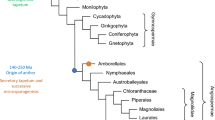Abstract
Conidiogenesis of the type species and two additional species of the genus Raffaelea Arx & Hennebert are described. In contrast to previous conclusions based on light microscopy that indicate sympodial production of the conidia, we found that conidium development was by annellidic percurrent proliferation in the type species Raffaelea ambrosiae, as well as in Raffaelea arxii and Raffaelea albimanens. Consequently, this mode of conidium development is similar to the conidiogenesis of anamorphs within the Ophiostomatales, but distinguished by sporodochia formed within the genus Raffaelea. These findings reduce the differences between Raffaelea and other anamorphs with annellidic percurrent proliferation of the conidiogenous cells within the Ophiostomatales to different conidiomata and conidiophores, and they support previous reports of the close phylogenetic relationship between Raffaelea and Ophiostoma.
Similar content being viewed by others
References
L.R. Batra (1963) ArticleTitleEcology of ambrosia fungi and their dissemination by beetles Trans. Kansas Acad. Sci. 66 213–236
L.R. Batra (1967) ArticleTitleAmbrosia fungi: a taxonomic revision and nutritional studies of some species Mycologia 59 976–1017
R.A. Beaver (1989) Insect-Fungus relationships in the bark and ambrosia beetles N Wilding N.M. Collins P.M. Hammond J.F. Webber (Eds) Insect Fungus Interactions Academic Press New York and London 121–143
E. Benade M.J. Wingfield P.S. van Wyk (1996) ArticleTitleConidium development in the Hyalorhinocladiella anamorphs of Ceratocystiopsis minuta-bicolor and Ophiostoma minus Can. J. Bot. 74 891–897
B.D. Farrell A.S. Sequeira B.C. ÓMeara B.B. Normark J.H. Chung B.H. Jordal (2001) ArticleTitleThe evolution of agriculture in beetles (Curculionidae: Scolytinae and Platypodinae) Evolution 55 2011–2027 Occurrence Handle1:STN:280:DC%2BD38%2Fjt1yqsw%3D%3D Occurrence Handle11761062
Francke-Grosmann H. 1956. Grundlagen der Symbiose bei pilzzüchtenden Holzinsekten. Verhandl. Deutsch. Zool. Ges. Hamburg 1956: 112–118.
H. Francke-Grosmann (1967) Ectosymbiosis in wood-inhabiting insects S.M. Henry (Eds) Symbiosis, vol. 2 Academic Press New York and London 141–203
H. Gebhardt D. Begerow F. Oberwinkler (2004) ArticleTitleIdentification of the ambrosia fungus of Xyleborus monographus and X. dryographus (Coleoptera: CurculionidaeScolytinae) Mycol. Prog. 3 95–102
T.E. Hinds (1971) ArticleTitleInsect transmission of Ceratocystis species asssociated with aspen cankers Phytopathology 62 221–225
S.J. Hughes (1953) ArticleTitleConidiophores, conidiaand classification Can. J. Bot. 31 577–659
G.J. Jones M. Blackwell (1998) ArticleTitlePhylogenetic analysis of ambrosial species in the genus Raffaelea based on 18S rDNA sequences Mycol. Res. 102 661–665 Occurrence Handle10.1017/S0953756296003437 Occurrence Handle1:CAS:528:DyaK1cXkt1egsrs%3D
J. Juzwik D.W. French (1983) ArticleTitleCeratocystis fagacearum and C. piceae on the surfaces of free-flying and fungus-mat-inhabiting nitidulids Phytopathology 73 1164–1168
T. Kubono S. Ito (2002) ArticleTitleRaffaelea quercivora sp. nov. associated with mass mortality of Japanese oak, and the ambrosia beetle (Platypus quercivorus) Mycoscience 43 255–260 Occurrence Handle10.1007/s102670200037
J. Lévieux D. Piou P. Cassier M. André D. Guillaumin (1994) ArticleTitleAssociation of phytopathogenic fungi for the scots pine (Pinus sylvestris L.) with the european pine weevil Hylobius abietis (L.) (Col. Curculionidae) Can. Ent. 126 929–936
D. Malloch M. Blackwell (1993) Dispersal biology of the ophiostomatoid fungi M.J. Wingfield K.A. Seifert J.F. Webber (Eds) Ceratocystis and Ophiostoma: Taxonomy, Ecology and Pathology APS Press St. Paul, Minnesota 195–206
A. Mathiesen-Käärik (1953) ArticleTitleEine Übersicht über die gewöhnlichen mit Borkenkäfern assoziierten Bläuepilze in Schweden Meddelanden Fran Statens Skogsforsinginstitut 43 1–74
K.A. Seifert (1985) ArticleTitleA monograph of Stilbella and some allied Hyphomycetes Stud. Mycol. 27 1–235
A. Tsuneda Y. Hiratsuka (1984) ArticleTitleSympodial and annellidic conidiation in Ceratocystis clavigera Can. J. Bot. 62 2618–2624
H.P. Upadhyay W.B. Kendrick (1975) ArticleTitleProdromus for a revision of Ceratocystis (Microascales, Ascomycetes) and its conidial states Mycologia 67 798–805
J.A. Von Arx G.L. Hennebert (1965) ArticleTitleDeux champignons ambrosia Mycol. Mycopathol. Appl. 25 309–315
H.S. Whitney (1982) Relationships between bark beetles and symbiotic organism J.B. Mitton K.B. Sturgeon (Eds) Bark beetles in North American conifers University of Texas Press Austin 118–211
M.J. Wingfield (1985) ArticleTitleReclassification of Verticicladiella based on conidial development Trans. Br. Mycol. Soc 85 81–93
M.J. Wingfield P.S. van Wyk B.D. Wingfield (1987) ArticleTitleReclassification of Phialocephala based on conidial development Trans. Br. Mycol. Soc. 89 509–520
M.J. Wingfield P.S. van Wyk P.W.J. van Wyk (1989) ArticleTitleConidial development in the anamorph of Ophiostoma cucullatum Mycol. Res. 93 91–95
M.J. Wingfield B. Kendrick P.S. van Wyk (1991) ArticleTitleAnalysis of conidium ontogeny in anamorphs of Ophiostoma: Pesotum and Phialographium are synonyms of Graphium Mycol. Res. 95 1328–1333
Author information
Authors and Affiliations
Corresponding author
Rights and permissions
About this article
Cite this article
Gebhardt, H., Oberwinkler, F. Conidial development in selected ambrosial species of the genus Raffaelea. Antonie Van Leeuwenhoek 88, 61–65 (2005). https://doi.org/10.1007/s10482-004-7838-8
Received:
Accepted:
Issue Date:
DOI: https://doi.org/10.1007/s10482-004-7838-8




